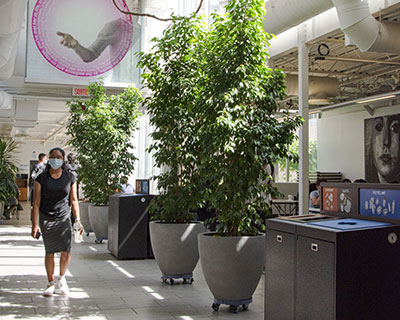Bringing Nature in to Dawson
About 1,200 plants and trees were installed inside the main building of Dawson College during the last 12 months. A major delivery of plants arrived during the first week of classes.
“These plants inject life into our indoor environment, boost our mood and clean the air,” said Diane Gauvin, Director General of Dawson College.
Consultant Leslie Thompson of Planterra, who also holds a Bachelor’s degree in Science (Agriculture), chose plants according to the natural and artificial light of specific areas in the College. She was also looking for “maximum leaf surface area for absorbing toxins and releasing oxygen,” she said. These plants and trees include 12-foot Ficus Benjamina Spire trees, Schefflera amate and Clusia.
Dawson has gone beyond
“The trend toward bringing plants inside has skyrocketed since the pandemic began. Dawson has gone beyond what many larger institutions are doing by including floor plants throughout common areas,” Leslie said. “There are double the plants at the College compared to what I have seen in other schools.”
Many of the trees and large plants can be found in the common areas of the Upper Atrium and Conrod’s. “I think the plants have a calming effect on us,” said Monique Magnan, Director of Student Services. “The students also really appreciate the lounge with the living wall in the First-Year Students’ Office. They like the ambiance created by the living wall.”
During the first week back on campus for employees, managers distributed over 1,000 plants to employees. After those welcome days, the remaining plants were distributed to offices all over the campus. The kinds of plants were chosen for their easy maintenance: Philodendron Cordatum, Red Maranta, Golden Pothos, Dracaena Florida Beauty and Philodendron Brazil.
Perfect Sustainable Happiness project
Lucy Segal and Carey-Ann Pawsey of the Communications Office oversaw the plant and honey distribution welcome back project. “This giveaway connected all the aspects of the Sustainable Happiness facilitator course I’m taking. It was a perfect project that reinforced the objective of connecting us more deeply to Nature and well-being for all,” Lucy said.
Lucy added that design can feel out of reach for many. “However, the addition of a plant or aromatherapy to a room or office can create a stress-free, relaxing environment that people can experience and share. Between natural light, vistas (or windows), plants, smells, sounds and textures, there is significant evidence that this can enhance our day-to-day experience. I’m so glad employees were excited about these gifts, it has been such a positive response and I hope to continue greening our spaces!”
Impact of plants
There is so much evidence of the important role that plants can play as psychologically restorative agents that help with mental fatigue and anxiety according to Chris Adam of the Sustainability Office.
“Plants represent life and tranquility,” Chris said, “and they are often associated with friendly and safe spaces. Having plants in schools and increasing plant biodiversity on campus grounds have been shown to have positive correlations to positive emotions, productivity, absenteeism, job satisfaction and general well-being. These micro-restorative places are often underrated in their influence in creating a community that flourishes.”
Consultant Leslie Thompson of Planterra recommends the following plants that can tolerate lower light conditions:
- Zamifolia
- Aglaonema
- Sansevieria
- Rhapis Palm
- Dracaena
- Philodendron
- Aspidistra



